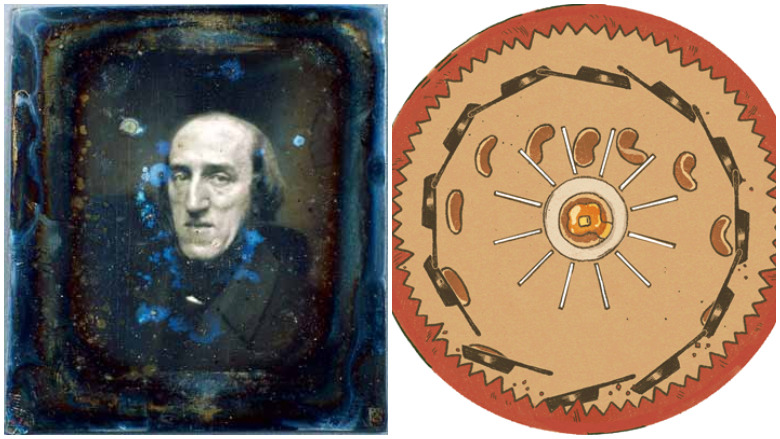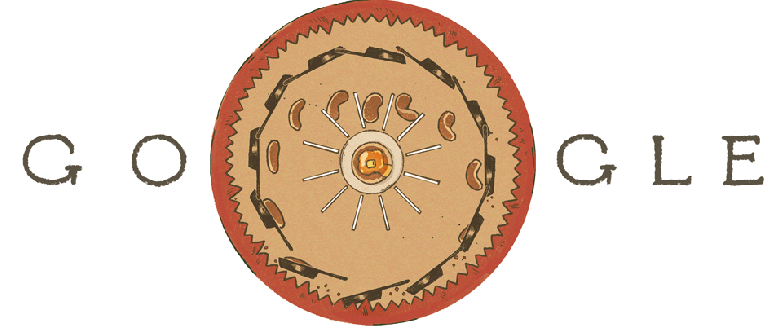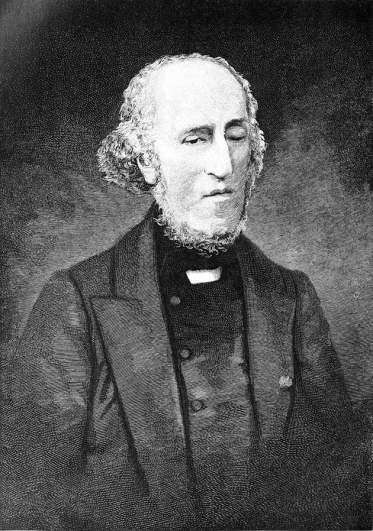
Wikimedia Commons/Google Joseph Antoine Ferdinand Plateau
Joseph Antoine Ferdinand Plateau is a Belgian physicist who invented a device called phénakistiscope, which is credited with leading to the birth of cinema. For that reason, he is sometimes called the “Father of Film.”
Plateau was honored with a Google Doodle on October 14, 2019 on what would have been his 218th birthday. According to Google, it was Plateau’s “research on visual perception” that led to the world-changing invention. The device created “the illusion of a moving image.” The Google Doodle is animated in honor of Plateau’s style. It’s the “first Google Doodle with different artwork showing up across different device surfaces—desktop, mobile, and the Google App,” Google reports.
“After studying law, young Plateau became one of the best-known Belgian scientists of the nineteenth century, remembered for his study of physiological optics, particularly the effect of light and color on the human retina,” Google wrote.
Here’s what you need to know:
1. Plateau Was Born in Brussels to a Father Whose Talent Was Painting Flowers

GooglePlateau Google Doodle.
Joseph Antoine Ferdinand Plateau was born in Brussels, Belgium in 1801. His family tree was steeped in artistry.
A lengthy 1800s era biography on Plateau by Gustaaf Van der Mensbrugghe, accessed here, says that Plateau was born in Brussels on October 14, 1801; his father, born at Tournai, “had a remarkable talent in the painting of flowers.”
“Raised in an artistic milieu, the young Joseph could read at six, which at that time made him look like a prodigy,” the article says.
“Sent to primary school, he made rapid progress; one day he attended a session of amusing physics, which struck his intelligence; Enchanted by the experiments of which he had been an attentive witness, he promised himself, no doubt, to penetrate the secret sooner or later.”
However, he suffered tragedy early on. His parents died, and his uncle Thirion, a lawyer, became his guardian when he was a teen. Joseph was sickly, so he spent a lot of time in the country, drawing and collecting butterflies, according to Science Museum.
Art crossed with an understanding of mechanics in a way that produced the ultimate invention. “Almost every year the young schoolboy would spend his holidays at the castle of Marche-les-Dames, at his grand-uncle’s, M. Jaumenne, master of ironworks,” the Van der Mensbrugghe article states. “He met there with his cousin Auguste Payen, who later became chief architect of the state’s railroads. He liked to visit the workshops of his great-uncle with his comrade, and the spectacle of the applications of mechanics struck his mind.”
2. Plateau Studied Philosophy & the Sciences

Joseph Antoine Ferdinand Plateau
Plateau was an educated man with many interests. According to the Catholic Encyclopedia, he began studying at the University of Liège in 1822. He focused on philosophy and literature but eventually graduated doctor of physical and mathematical sciences in 1829.
“After a brief period of teaching in the Athenee Royal at Liège, he was appointed, in 1835, professor of experimental physics in the University of Ghent,” the site reports. His doctoral adviser was Adolphe Quetelet, who was a great influence on Plateau.
Plateau wrote his doctoral dissertation on the way in which images form on the retina. According to the Catholic Encyclopedia, technically his dissertation was on “certain properties of the impressions produced by light upon the organ of sight.” He noted their “exact duration, color, and intensity.” He used this research to make a stroboscopic device in 1832, “fitted with two discs that rotated in opposite directions,” Google wrote.
“One disc was filled with small windows, evenly spaced in a circle, while the other had a series of pictures of a dancer. When both discs turned at exactly the right speed, the images seemed to merge, creating the illusion of a dancer in motion,” described Google.
History.mcs describes the concept that led to motion pictures this way: “He discovered that by observing a periodically moving object through a hole in a rotating disk, it was possible to make the object appear stationary by rotating the disk at a suitable speed.”
3. Plateau Lost His Vision in Later Years But That Didn’t Stop His Mental Acuity
In later years, the man who created the foundation for modern cinema went blind. According to Google, he didn’t stop working on experimental physics. His son and son-in-law were involved in the research.
History.mcs reports that Plateau’s vision began to fail in 1841 when he suffered “inflammation of his eyes,” that resulted in blurred vision. Within two years, he was completely blind. This didn’t stop his powerful mind, however.
“… although bodily Plateau remained plunged in the darkness of a sad profound night, the perspicacity of his mind, having become more intensive than ever, was to lead to the most brilliant discoveries and to conquer for Belgium science an immortal glory,” a person who knew him said, according to History.mcs.
Neuro Portraits.eu reported of his blindness that Plateau “was temporarily blinded after looking at the sun for 20 s in order to generate a long lasting afterimage, and he became permanently blind in 1842 from uveitis.”
4. Plateau Was Described as Having a ‘Vivid’ & ‘Humorous’ Character
According to History.mcs, contemporaries praised his character, not just his intellect. They said Joseph Plateau had a “vivid and humorous character,” with a memory that “seldom let him down” and that grew stronger with age.
He enjoyed inviting visiting scholars into his home.
According to History.mcs, Plateau married Augustine Thérèse Fanny Clavareau in 1840; they had two sons together named Félix and Ernest, and a daughter Alice.
In another finding, Neuro Portraits.eu explains, Plateau discovered that “when colours are presented briefly and in succession their apparent intensity is proportional to the time of presentation.” This principle became known as the Talbot-Plateau law.
5. The Google Doodle Animations Are Meant to Reflect Plateau’s Style
The Google Doodle was created by Olivia Huynh, “with inspiration and help from Diana Tran and Tom Tabanao,” according to Google. She’s an animator and filmmaker.
“I enjoy Plateau’s broad range of interests. I think it’s a good message to show that you can be interested in lots of things, like science, math, art, invention, craft, and that they can overlap,” she told Google.

Google’s animations are different depending on the device.
Of the Doodle, she added, “I hope people will feel interested in the long history of animation and film! Also, maybe people will try animating if they’re interested. The animations in this Doodle were all only 12 drawings each.”
READ NEXT: Sir William Ramsay Google Doodle.
